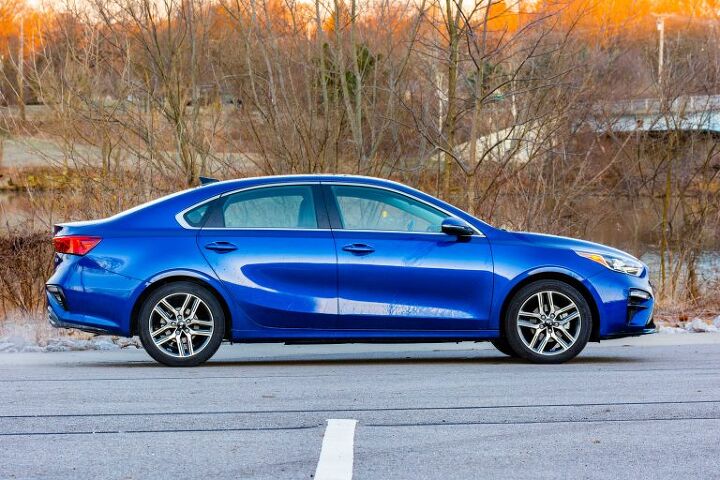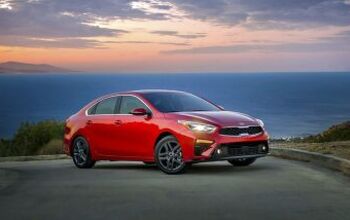2019 Kia Forte Review - Basic Done Best

2019 Kia Forte EX
I’ll grant that I’ve established a pretty cool second job for myself with this gig writing about cars. What gearhead wouldn’t love to get paid to talk (well, write) about their favorite subject — and often, drive some of the coolest new cars around? It sure beats flipping burgers to put extra cash in the wallet.
The not-so-secret side of this? It’s generally not the coolest cars that generate the most clicks. Most readers tend to care about cars they’ll legitimately consider buying, rather than a $100k sportscar. Thus, reviews of basic commuter cars, while not nearly as fun to drive, are much more important.
My job was made easy for me with the 2019 Kia Forte. It doesn’t overwhelm with outlandish styling. It doesn’t get the juices flowing with incredible performance. It simply makes the daily commute effortless and economical. What else can you ask from a car?
Kia has done a remarkable job moving styling cues from its halo Stinger onto this compact Forte. While nobody will mistake the two, it’s led to a properly handsome entry-level sedan. I especially appreciate the ridges on the hood, creating the illusion of an old-school power bulge. (Old School Power Bulge would make a great cover band name, incidentally.) The LED detail to the taillamps is a nice touch. The rest of the rear is a bit busy, however, with the black triangular housing for the reversing lamps and turn signals looking a bit tacked-on.
The interior is typical Kia – plain, simple, and well thought-out. Infotainment controls on the touchscreen are simple and intuitive, though I prefer to use the matching knobs and buttons on the steering wheel. Standard dual-zone climate control is unexpected in this class, but is quite welcome – as are the available heated and cooled front seats.
I especially appreciate the two-tier cubby ahead of the shifter, perfectly sized for a pair of cell phones. Too few carmakers acknowledge that the front passenger needs to set their phone down. The top tier of that cubby features Qi wireless charging – always welcome, as I can never remember to bring a USB cord.
If you do remember the cord, Android Auto and Apple CarPlay are standard on all Forte trims, as is that eight-inch touchscreen. Further standard features include forward collision avoidance and warning systems, paired with lane keeping assistance. This EX Launch Edition tester came fitted with optional blind spot warning and rear cross-traffic alerts.
Rear seat room was plenty for our kids. While I certainly couldn’t fit “behind myself,” I’m larger than the average human. Don’t make a habit of transporting the entire varsity basketball team, and the Forte will be comfortable for all involved.
Driving the Forte is a pleasantly unremarkable experience. Other than some thumps when hitting Ohio potholes squarely, the ride is muted, with little of the usual wind or road noise seeping through to the cabin. Soft springs add a bit of lean when negotiating corners, but this means occupants have a controlled, gentle ride. This is neither a sports sedan nor a hot hatch, recall?
I was surprised when I looked at the transmission line on the spec sheet. Indeed, while the Forte is fitted with a CVT, it exhibited none of the typical annoying traits of the genre. Nothing but smooth, quiet power delivery from the Forte. It’s not neck-snapping, by any means – off-the-line performance is a tad sluggish with 147 hp – but it’s more than adequate for most drivers. Efficiency is quite good. Were I commuting on the interstate more often, I can easily imagine approaching the 40 mpg figure quoted by the EPA.
Should I choose to purchase my own Kia Forte, I’d likely forgo some of the fancier features and embrace my inner cheapskate with the entry-level FE trim. Sadly, the Ace of Base model only offers a trio of colors: white, black, and grey, though it offers an extra MPG when fitted with the CVT transmission over the more-plush EX models. At $19,615 delivered, I’d be quite happy driving with a small monthly payment.
That’s what the Forte excels at – it’s a lot of car for a low payment. It’s a cheap car that doesn’t look it. It’s comfortable, performs well, and is inexpensive to run. Embrace basic, because basic is all most drivers need.
[Images: © 2019 Chris Tonn/TTAC]

Some enthusiasts say they were born with gasoline in their veins. Chris Tonn, on the other hand, had rust flakes in his eyes nearly since birth. Living in salty Ohio and being hopelessly addicted to vintage British and Japanese steel will do that to you. His work has appeared in eBay Motors, Hagerty, The Truth About Cars, Reader's Digest, AutoGuide, Family Handyman, and Jalopnik. He is a member of the Midwest Automotive Media Association, and he's currently looking for the safety glasses he just set down somewhere.
More by Chris Tonn
Latest Car Reviews
Read moreLatest Product Reviews
Read moreRecent Comments
- Ajla I did like this one.
- Zerofoo No, I won't miss this Chevrolet Malibu. It's a completely forgettable car. Who in their right mind would choose this over a V8 powered charger at the rental counter? Even the V6 charger is a far better drive.
- Offbeat Oddity Nope, I won't miss it. I loved the 2008-2012 Malibu, but the subsequent generations couldn't hold a candle to it. I think the Impala was much more compelling at the end.
- Zerofoo An almost 5000 pound hot hatch that fell out of the ugly tree and hit every branch on the way down? No thanks.
- Tassos Jong-iL This would still be a very nice car in North Korea.












































Comments
Join the conversation
Given how often the bumpers of urban driven vehicles are scraped and dented from parking lot accidents and the like, there's going to be a lot of 5-10 year old Kia Fortes tooling around with busted and missing turn signals/back up lights.
I'm 50/50 on H/K products. A colleague at work has a 2008 Sante-Fe that he had to be junked because the entire front frame rotted out. This was after he just spent 2K on replacing the transmission last year, most front end components and the famous harmonic balancer on the engine the year before. It currently had 120K miles. I worked with a copier firm that used a 2005 Sante-Fe with the 2.7 that got used daily and very well serviced. In 2008 that same owner contacted me for assistance with some special large capacity printers and we got talking about his Sante Fe. it needed it's engine replaced with around 130K on the clock because it developed a knock and was using a lot of oil. Another friend's grandma bought a 2013 Sonata SE brand new and the 2.4 engine locked up while they were driving requiring a new engine at only 90K miles. Thankfully the warranty was still in effect to cover that. And this isn't the first person I have spoke to needing a 2.4 engine replaced. Then I have other friends with newer 2014-2016 H/K vehicles that have had better luck with more minor issues in a 100K mileage period. Their interiors certainly seem nice on the surface and their other engines like the 1.6, 2.0 and 3.3 V6 engines seem to be reliable so far.